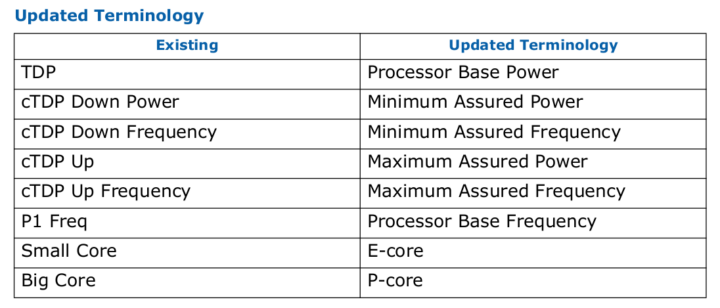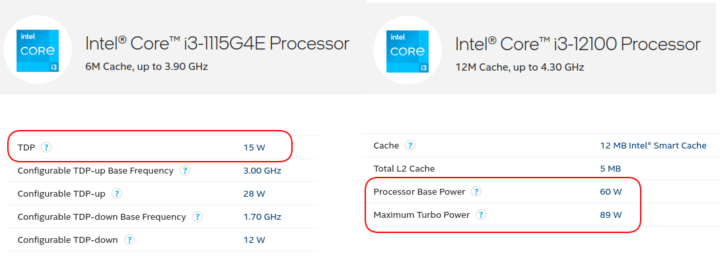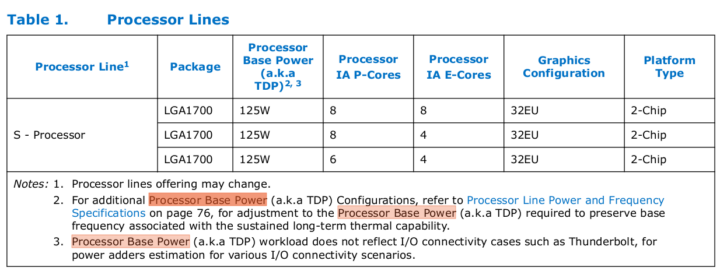TDP (Thermal Design Power) metric has been used for years to help manufacturers design appropriate cooling solutions for Intel/AMD processors and give an idea of their power consumption. But I did not immediately catch up that TDP was gone from the recent Alder Lake IoT processors announcement, and Intel is now using PBP (Processor Base Power) instead, while somehow cTDP (configurable TDP) down/up numbers are still provided.
Beyond the announcement, if we look into the Intel Ark database, older processors still show TDP, while it’s completely gone for new processors with the specs instead listing Processor Base Power (PBP), and for the ones with Turbo mode “Maximum Turbo Power” (MTP) is also included.
But what do those mean exactly? Intel “explains”:
TDP definition:
Thermal Design Power (TDP) represents the average power, in watts, the processor dissipates when operating at Base Frequency with all cores active under an Intel-defined, high-complexity workload. Refer to Datasheet for thermal solution requirements.
PBP definition:
The time-averaged power dissipation that the processor is validated to not exceed during manufacturing while executing an Intel-specified high complexity workload at Base Frequency and at the junction temperature as specified in the Datasheet for the SKU segment and configuration.
MTP definition:
The maximum sustained (>1s) power dissipation of the processor as limited by current and/or temperature controls. Instantaneous power may exceed Maximum Turbo Power for short durations (<=10ms). Note: Maximum Turbo Power is configurable by system vendor and can be system specific.
I wrote “explains” in quotes because Intel does not provide any information about the “high-complexity workload”, so we are left to guess. In the past, a processor was just comprised of the CPU cores, but those are now SOCs with GPU for 2D/3D graphics and hardware video acceleration, as well as AI or other accelerators. So it may be important to know if the workload makes any use of those. I initially thought TDP and PBP looked similar enough to me except the junction temperature was specified. But tkaiser commented that “all cores” was removed from the PBP definition, and this suggests Intel might be using the other IP blocks as well, also noting that TDP has become meaningless to estimate the power consumption of a processor as explained in an ExtremeTech article.
Let’s check out Alder Lake processors datasheet to find out if we can find additional information.
Nearly every mention of “Processor Base Power” is followed with “a.k.a TDP”, so from Intel’s perspective, both are the same. What we still don’t get is a clear explanation of how the numbers are calculated, so Intel must consider this confidential information.
If we look into the second part of the Alder Lake datasheet, this is even more clear, as somebody at Intel decided to rename a bunch of terms…
 cTDP Down power is now minimum assured power, cTDP Up power is maximum assured power, Small Core has become “E-Core” (Efficient), and Big Core is P-Core (Performance). I think the reason for the change from “Thermal Design Power” to “Processor Base Power” is to offer a way to differentiate with the new “Maximum Turbo Power” metric since the former relies on the base frequency and the latter on the turbo frequency. So unless new information comes up, I’d consider TDP and PBP to represent the same metric.
cTDP Down power is now minimum assured power, cTDP Up power is maximum assured power, Small Core has become “E-Core” (Efficient), and Big Core is P-Core (Performance). I think the reason for the change from “Thermal Design Power” to “Processor Base Power” is to offer a way to differentiate with the new “Maximum Turbo Power” metric since the former relies on the base frequency and the latter on the turbo frequency. So unless new information comes up, I’d consider TDP and PBP to represent the same metric.

Jean-Luc started CNX Software in 2010 as a part-time endeavor, before quitting his job as a software engineering manager, and starting to write daily news, and reviews full time later in 2011.
Support CNX Software! Donate via cryptocurrencies, become a Patron on Patreon, or purchase goods on Amazon or Aliexpress. We also use affiliate links in articles to earn commissions if you make a purchase after clicking on those links.






All that Intel has managed is to further muddy waters and show how inept they are at basic communication.
As the ExtremeTech article explains the TDP has become a pure marketing number.
There’s an i5-12500E with 6 P-Cores (12 threads) @ 2.9 GHz, 32 EU @ 300 MHz at 65W PBP. And then there’s Celeron G6900E with only 2 P-Cores (2 threads) @ 3.0 GHz, 16 EU @ 300 MHz at 46W PBP.
Let’s compare the 3.0 GHz Celeron G6900E with an older 2C/2T 2.8 GHz Celeron: N4500. G6900E has a PBP rating of 46W while N4500 has a 6W TDP (the trick here is listing N4500’s Base Frequency as 1.1GHz).
i5-12500E vs. G6900E: 2 vs. 6 identical cores at same process node at identical Base Frequency showing 46W vs. 65W in a new metric called ‘Processor Base Power’.
Can this be expained by binning?
No, especially as the Celerons are usually very bad bins of other CPUs.
It’s interesting, because historically celerons were known for being the best overclockers, some of them would accept more than doubling their frequency. That was before the multi-core era, so that couldn’t even be justified by disabling the bad cores.
That was a very long time ago. And overclocking isn’t always related to binning, at least not these days, as there are so many factors involved in what silicon becomes which type of CPU. Overclocking is also mostly dead these days, as the CPU manufacturers have become a lot better at binning their chips and Intel obviously only allows it on its K SKUs.
They are making it hard for customers to compare like for like, against competing manufacturer SoC. It is a marketing way of defending against competition.
Frankly, I’ll say that putting the “maximum turbo power” front and center alongside what was formerly known as “TDP” is MORE HONEST than Intel’s previous practices. It’s not just in ARK, you can see both numbers on slides. This is an improvement.
As for comparing to the competition, the only way that can be done is with third-party reviews. Even testing something as simple as Cezanne vs. Rembrandt can be complex, without throwing in a mix of Performance and Efficiency cores.
Why they don’t define a (useful) measuring procedure (BOINC, etc.) for cpu/gpu/npu/sram/networking/integrated peripherals (other hardware with high power consumption during peak performance demands) for at least 5(-15) minutes endurance (current/thermal throttling will reduce power consumption and heat transfer, all along a socket/cpu/cooler/case line), with averaging that energy consumption for that time? This would be a number interesting for thermal components and power supply.
Comparing cpus is comparison between cpu cores and cpu/gpu (amd64) combinations (if contributing thermally) and massively increased sram (depending on cpu generations)?
Additionally providing a number for highest instant power consumption (MTP).
There’s TDP/BPB and MTP number (but ‘Base Frequency’ instead of ‘Turbo Frequency’ power is not that useful for dimensioning cooler and power supply, especially if there’s 1.5-2.xGHz(?) difference and turbo frequency consumes (sustained) extraordinary power increase)?
If it gets to professional dimensioning of components, they could provide a diagram for frequency/power relation (because (lower) TDP number is meaningless without knowing frequencies enabled for system design)?
If it comes to idling frequencies, smart hibernation mostly would/could be more useful?
I’d say that instant max power consumption per frequency would do the job. The highest frequencies in turbo mode usually last shortly nowadays (typically 20s) and for small heat sinks it’s important to really focus on short-time consumption. Having this would significantly help manufacturers design their cooling solutions. After all it seems easier in the SoC world where everyone adjusts their OPP allowing to even run without a heat sink with peak frequencies not lasting long.
Not fair enough for specification and efficiency oriented customers, with lower interest in hardware and relying on TDP numbers, what was shown by extremetech through a diagram ( https://www.extremetech.com/wp-content/uploads/2021/01/10700KIntelvsMB-640×419.png ). It depends on BIOS/UEFI configuration, if highest turbo frequencies only last for tens of seconds or minutes or even get permanent with performance demand. Overclockers won’t complain, but they asked if it’s processor company’s responsibility to declare more clearly or limit cpus to (guaranteed) TDP or mainboard manufacturer’s to provide an easy configuration tool for customers without hardware experience or interest in that details.
Seems there are now about 4 frequency levels to identify: highest turbo, lower (sustained) turbo, high base and low base frequency (and dynamically changing within). Not far from showing a diagram for information about instant power (TDP) for frequencies.
But maybe it’s to divide into customers for mobile/embedded or desktop/workstation solutions?
It’s going to get exciting about how much difference is between performance numbers for E-cores on sustained turbo frequencies and P-cores on low base frequencies and what configuration range will be given to customers?
( high power chipsets getting active heat dissipation, again? )